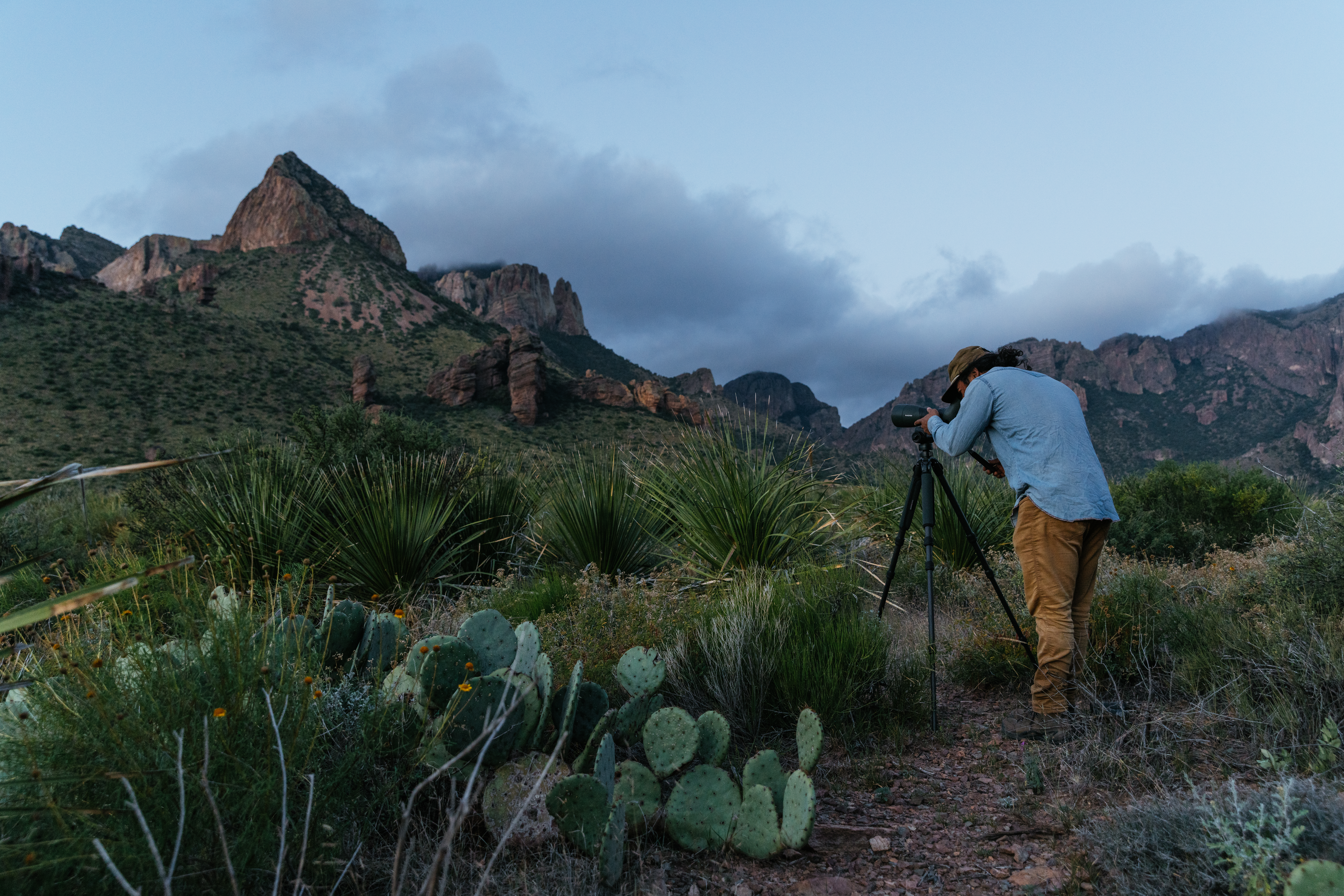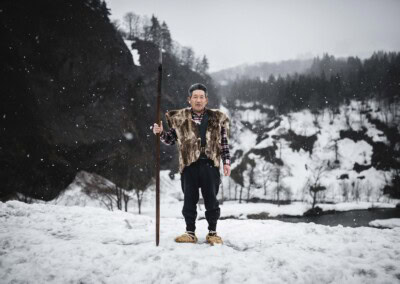Your cart is empty
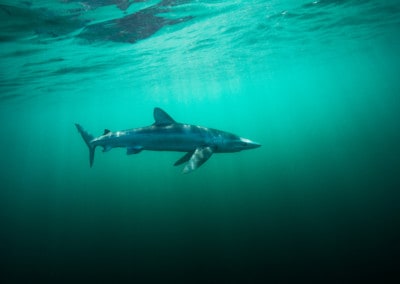
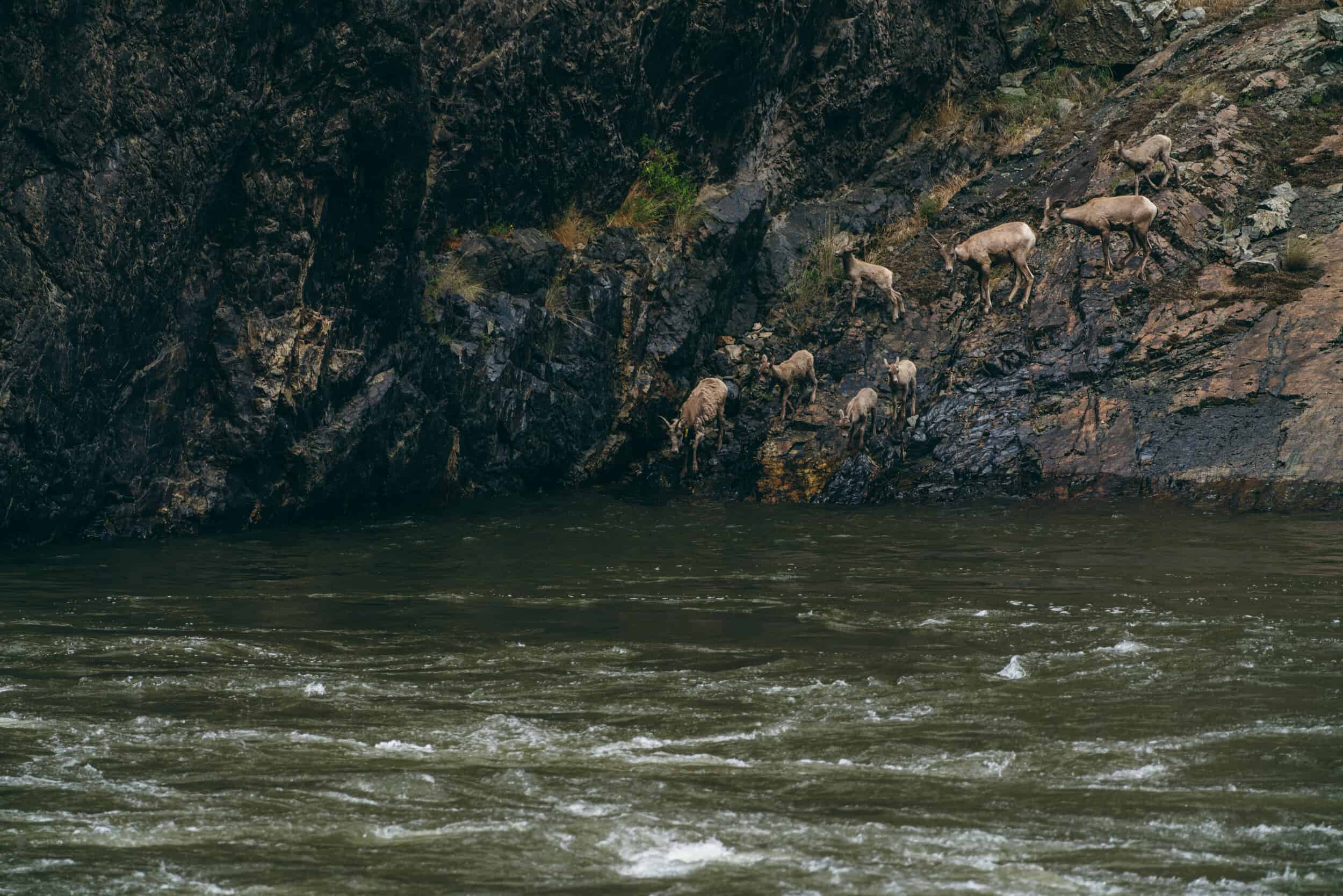
My forehead and the tip of my nose are numb, pressed up against the cold truck window. I watch as Dr. Kevin Monteith and Brittany Wagler trudge through the snow, sneaking up on a small group of ewes and rams at the base of a ridge. I hold my breath as Brittany raises the gun to her shoulder, I watch as the dart filled with BAM, a drug that chemically immobilizes the animal (i.e., puts them to sleep), sinks into the rump of the ewe but she doesn’t drop to the ground like I thought she would. Instead, she bolts — sprinting up the side of a cliff face, navigating up through rock outcroppings, until she finally plops herself down almost out of sight.
“She’s down, let’s go!” Rachel Smiley says to me and we jump out of the truck, slinging heavy packs onto our shoulders loaded down with fieldwork gear and trudge up the rocky slope toward the ewe. Brittany and Rachel are graduate students in the Monteith Shop, a research group based out of the University of Wyoming in the Haub School of Environment, Natural Resources, Wyoming Cooperative Fish and Wildlife Research Unit. The female duo is in their 2nd year of work on a new study that dives deep into how disease, nutrition, and population densities interact in Rocky Mountain Bighorn Sheep (Ovis canadensis canadensis).

It’s no secret that bighorn sheep are struggling across the West and have been for the last century; wildlife managers attribute many of the declining numbers in herds to a deadly disease called pneumonia. Originally, wild bighorn sheep were exposed to pathogens that cause pneumonia from domestic sheep, but the relationship of disease transmission and recurrence of disease is more complicated than just separating wild sheep from domestic sheep. “Even in places where there is no new contact between wild sheep and domestic sheep, the pathogens that cause pneumonia still persist in causing the population to crash and die-off events to occur over and over again,” Dr. Monteith explains to me.
While other studies seem to focus more on the disease, especially the strains of bacterial respiratory pathogens that lead to pneumonia in sheep, Monteith’s study aims to unearth a deeper understanding as to why the frequency and intensity of die-offs caused by pneumonia are inconsistent; and if these disease events may be dependent upon certain ecological or environmental conditions like nutrition.
The study encompasses three bighorn sheep herds in Wyoming, including the Whiskey Mountain Herd, nestled in Wyoming’s Wind River Range which is one of the most well-known and historically largest herds in the lower 48. The herd was previously used to restore wild sheep populations. Wildlife managers translocated animals from the healthy Whiskey Mountain herd to struggling populations and to vacant habitats that historically supported wild sheep throughout the West up until 1991 when a pneumonia outbreak ripped through the herd drastically reducing the population. Today, the herd has yet to fully recover and remains in decline.

As I walk behind Rachel, I imagine what it would feel like to be a sheep with pneumonia trying to survive on this landscape — I would classify myself as a healthy and fit individual but even I am struggling to move through this terrain, breathing heavily and feeling the ache in my legs. As soon as we arrive at where the ewe has bedded down, the team whips out a green tank and starts administering oxygen and a pulse oximeter reading. Her temperature is recorded, blood is drawn, hair and fecal samples taken, body measurements noted, disease samples completed, lactation score given, body fat recorded by ultrasound and a GPS collar is secured around the neck.
Before I know it, the team administers a reversal drug and, in a few minutes, she scampers off and over the ridgeline. Upon our return to the truck, the biological samples are quickly put on ice and Rachel uses her telemetry, scanning and listening for the faint beeps that mean there are other collared sheep from the study nearby. Twice a year the team re-captures adult females, once in December as sheep are coming off their summer range and again in March after they have endured a long cold winter. Diligent monitoring allows the team to closely track how their nutritional condition, reproduction, and disease status varies with each season.
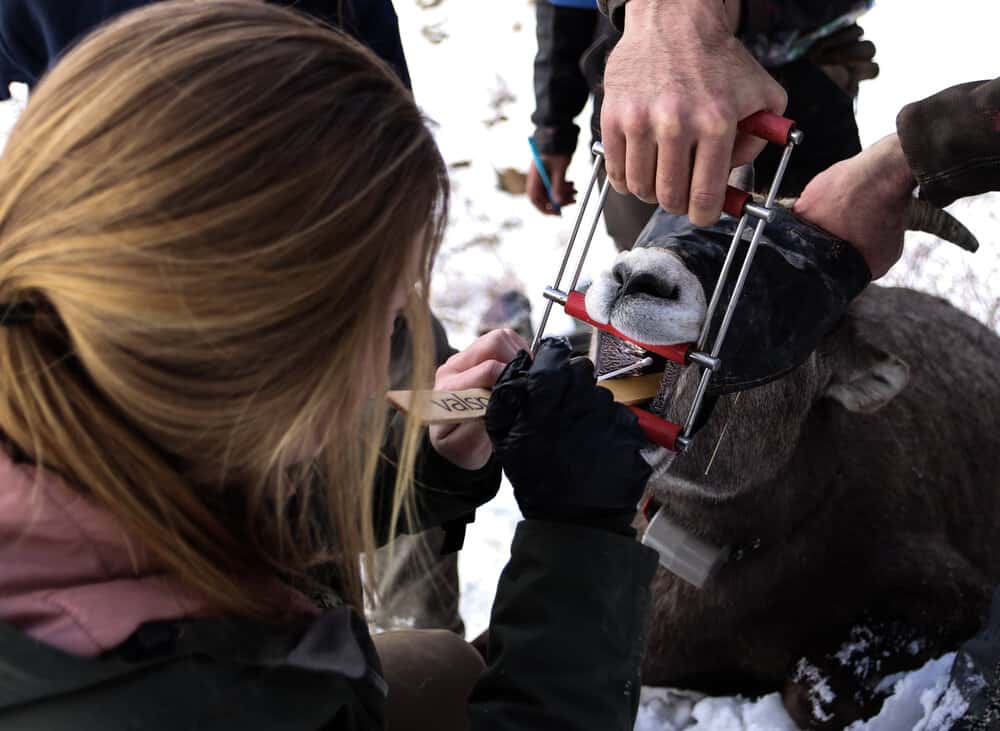
In March, the team outfits pregnant ewes with vaginal implant transmitters (VITS). When a ewe gives birth the VITS are expelled sending an email alert to Brittany and Rachel detailing the location of where the lamb was born. The team mobilizes as quickly as possible, trying to get to the lambs within 24 hours to take body measurements, nasal swabs, collect blood and secure a GPS collar around its neck. From early May through June the team tests their physical limits traversing snowfields and muddy springtime conditions, trying to make their way up to 10,000 feet where many lambs are born. A typical day for the crew means hitting the trail by 8 am, avoiding as many avalanches and rockslides as they can, and getting back to camp at around 2 am.
“We collared one lamb on the edge of a 1,500-foot cliff face surrounded by car-sized boulders and talus rock. She gave birth so close to the edge that she had kicked her VIT off the cliff and into the valley below,” Brittany tells me. Being a wildlife biologist who works with Wyoming’s bighorn sheep means you have to be as fit as a professional athlete, just to reach the sheep. Both Rachel and Brittany agree that the desire to study sheep is partly driven by being able to experience the places that these sheep inhabit.
“There are countless times where we have heavy packs and are traversing across ridgelines and cliffs where one wrong step would most likely end in death … but spending hours and hours tracking sheep surrounded by towering peaks, and pushing our physical limit is why we love it,” Brittany and Rachel explain.
Come midsummer after all the lambs have been born, the team starts collecting habitat data, walking transects to identify species abundance and diversity. After that is complete, they will then assess their habitat treatment plots that contain grazed, ungrazed, and burned subplots, as well as combinations of these treatments on the sheep’s summer range. While the habitat work might not be as thrilling as chasing after sheep, it is a crucial component that is commonly neglected when considering disease dynamics. “The nutritional condition of an animal is a direct product of their environment, and the more energy that is available in that animal to invest in their immune function and reproductive rates the more likely they are to survive,” Dr. Monteith says.
When Brittany and Rachel finally catch a break between their field seasons, they are piecing together how each ewe interacts with her environment, understanding her ability to survive and reproduce, while analyzing how she fits within the population in which she resides. These individual life histories of each sheep could yield potential management alternatives to help reduce the frequency of outbreaks allowing more time for the sheep populations to rebound from each pneumonia die-off event.
The last bit of light allows us to spot one of the sheep that Rachel and Brittany have been tracking with telemetry for hours, but she is across the creek in between cliff bands and thick timber. With the shooting hour closing in on us, the team decides to call it for the day. They will return at first light, telemetry and dart gun in hand — logging miles and elevation gain that would outrank most on the popular fitness app ‘Strava.’ A day in the life with these two badass female scientists has left me feeling sore and tired but most of all inspired.
You can find more information about this study and the work of the Monteith Shop by following @monteith.shop and @wyosheepproject on Instagram or online at Ungulate Compendium of North America.
Related Stories
Latest Stories

